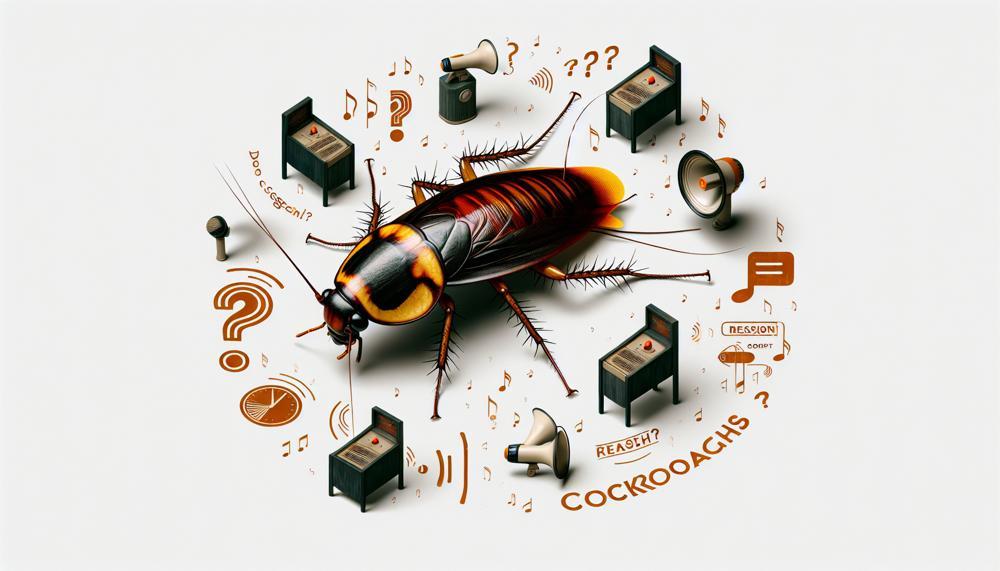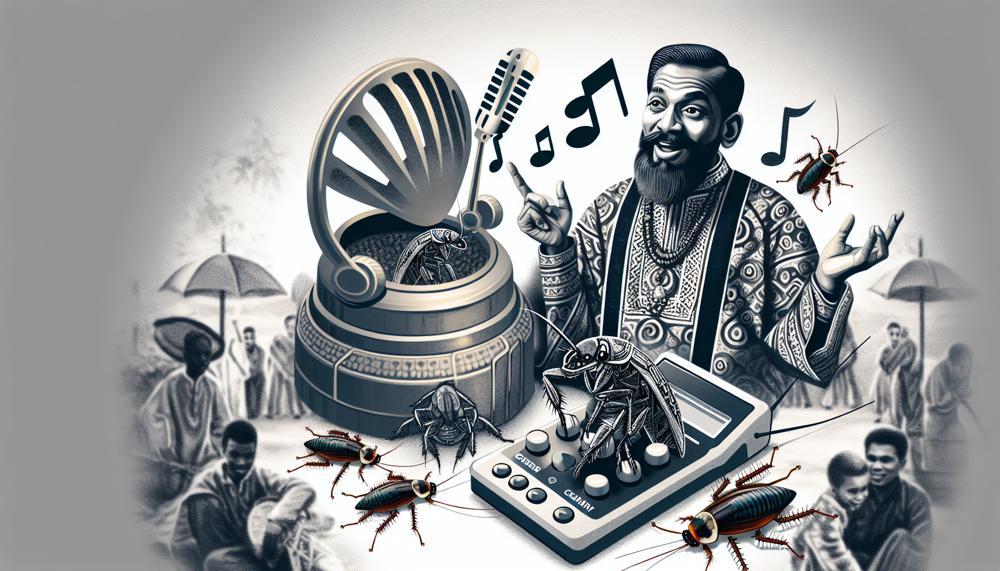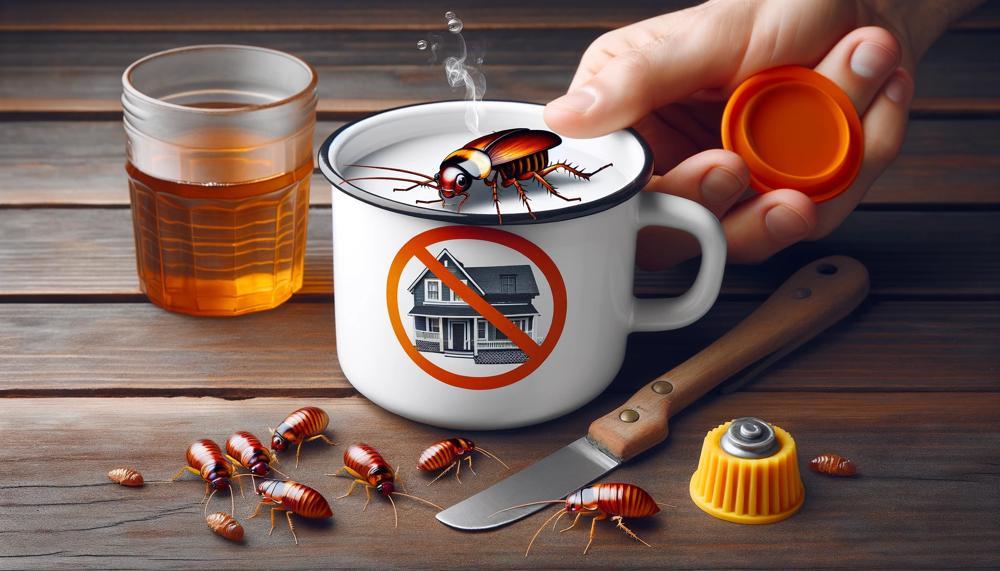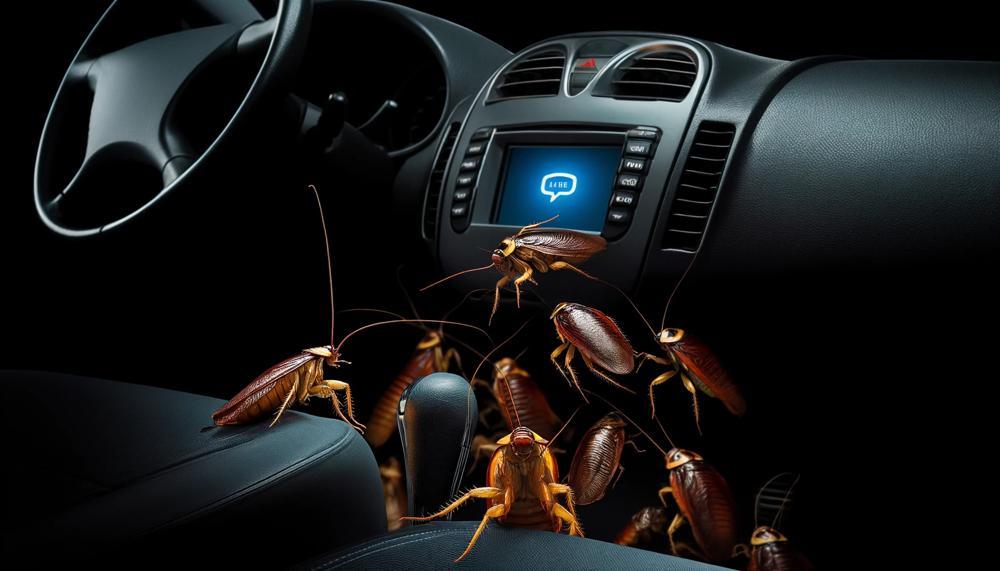Picture this: it’s very late at night, and you’re in bed, falling off to a peaceful sleep. All of a sudden, you hear something strange coming from your kitchen.
When you slowly turn on the light, you are startled to see a cockroach darting across the bar, making a clear clicking sound as it goes. Some people might be surprised to learn that these tiny bugs can cause a lot of noise.
Cockroaches are known for making a lot of different sounds, from soft chirps to loud hisses.
But why do they make noise? What does it mean? Let’s learn more about how cockroaches talk to each other and hear how loud these little bugs can be.
In order to make noise, cockroaches rub their wings together or against other parts of their bodies. Cockroaches use these sounds to talk to each other and figure out their surroundings.
Some species use sound to find mates or tell others about danger. And just like with people, the level and regularity of cockroach noises can change based on their size and where they are.
Table of Contents
- 1 Do Cockroaches Make Noise?
- 2 Why They Make Noise
- 3 What Is Stridulation?
- 4 What Types Of Cockroaches Are The Noisiest?
- 5 Listening For Different Cockroach Sounds
- 6 Do Cockroaches Make A Buzzing Sound?
- 7 Is It Possible To Hear Them Inside Walls?
- 8 Why It’s More Common To Hear Them At Night
- 9 Are Cockroach Sounds The Sign Of An Infestation?
- 10 Conclusion
Do Cockroaches Make Noise?
Cockroaches have a range of vocalizations, including chirping, clicking, hissing, and even squeaking. These noises serve as a means of communication and attracting potential mates.
However, due to their small stature and preference for dark and secluded areas, pinpointing the exact source of these sounds can prove to be quite challenging. Below are some methods for identifying the different types of noises produced by cockroaches:
- Chirping: Some cockroach species, such as the Madagascar hissing cockroach, create a chirping sound by rubbing their wings together. This particular sound is often used for mating purposes.
- Hissing: As mentioned earlier, the Madagascar hissing cockroach also produces an audible hissing sound through its breathing holes. Other species may also emit a similar noise when disturbed or feeling threatened.
- Clicking: Cockroaches sometimes click their mandibles together as a form of communication or defense mechanism. This clicking sound can often be heard when they are in groups or when they sense danger.
- Squeaking: Certain cockroach species can produce a high-pitched squeaking sound, typically used to attract potential mates or communicate with other roaches.
- Ultrasonic sounds: Some cockroach species emit ultrasonic sounds that are too high for humans to detect. This is believed to be a way for them to communicate without being detected by predators.
To identify these various noises, it is crucial to listen closely and attempt to determine their origin. Placing sticky traps or using a flashlight in dark areas may assist in locating the source of the sound.
Why They Make Noise
Cockroaches are known for their notorious nocturnal habits and preference for dark and secluded areas. In such environments, their noise plays a significant role in their survival. These pests use a variety of sounds, including chirping, hissing, and clicking, to communicate with each other and convey important messages.
One of the primary purposes of a cockroach’s noise is communication. These creatures rely on their sounds to stay in touch with other roaches in their vicinity. In close proximity, they may use chirping, hissing, or clicking to communicate about food sources, potential mates, or potential danger.
In addition to communication, cockroaches also use their noise to attract potential mates. By producing high-pitched noises like squeaks or chirps, they signal their availability for mating. These sounds can also serve as an indication of the availability of food and shelter.
But perhaps the most intriguing function of a cockroach’s noise is its defensive mechanism. When threatened by predators, these pests may hiss or click their wings as a way to intimidate or startle their attacker. This noise can also serve as a warning to other cockroaches in the area.
Aside from vocalizations, cockroaches also use pheromones to communicate with each other. These chemical signals transmit vital information about food sources, potential mates, and danger.
Pheromones also play a significant role in cockroach behavior, such as aggregation and dispersal.
What Is Stridulation?
Cockroaches have a variety of methods for producing sound, including chirping, hissing, and clicking. They use these noises to communicate with other cockroaches and attract potential mates. In addition to sound, they also use pheromones to convey messages and influence behavior.
| Type of Sound | Cause | Description |
| Chirping | Leg rubbing | By rubbing their bristly legs together, cockroaches create a chirping sound, much like playing a musical instrument. |
| Hissing | Air forced through spiracles | In times of danger, cockroaches can forcefully push air through their spiracles, resulting in a hissing noise. |
| Clicking | Wing or mandible tapping | Cockroaches can click their wings or mandibles together to create a clicking sound. |
| Ultrasonic sounds | Unknown | Some species of cockroaches are capable of producing ultrasonic sounds that are too high-pitched for humans to hear. |
Male cockroaches also chirp at night to attract female mates, which can be an indication of an infestation if heard inside homes. Other signs of an infestation include droppings, egg cases, musty odors, and sightings of roaches during the day.
Early intervention is crucial in managing a cockroach infestation. This can involve using insecticides, setting traps, and sealing any openings or cracks where they may be entering the home.
Additionally, maintaining a clean and clutter-free environment is essential, as cockroaches are attracted to food and moisture.
What Types Of Cockroaches Are The Noisiest?
When it comes to noise, the American cockroach, the Madagascar hissing cockroach, and the German cockroach are the top three. People know these species for the loud hissing, tweeting, and clicking sounds they can make. They use these sounds to talk to each other and to draw possible mates.
The American cockroach is one of the biggest insects in the world. Its screaming sound can reach a whopping 90 decibels. The Madagascar hissing cockroach, on the other hand, makes its unique sound by blowing out air through its pores.
Lastly, the German cockroach is known for making a noise called singing, which is thought to be a way for roaches to talk to each other.
If people are aware of these loud bugs, they can easily spot possible outbreaks and take the steps needed to get rid of them.
The “palmetto bug,” which is another name for the American cockroach, is common in many homes in the US. When I was a kid, I remember being scared of these big bugs that would crawl around our kitchen at night. What scared me even more, though, was the loud hissing sound we could hear throughout the whole house. Their ways of talking and how they use hissing to attract mates were something I didn’t learn about until I was older.
The Madagascar hissing cockroach, on the other hand, has become famous as a pet because of how it looks and acts. When I was a kid, I went to see a friend who had one as a pet and was amazed by how loud it hissed. When it hissed, it was almost like a small concert in their aquarium.
Finally, the German cockroach isn’t very big, but its loud tweeting sound more than makes up for it. I remember hearing these buzzing sounds coming from our kitchen when I was a kid living in an apartment building.
I thought it was a bird at first, but I quickly learned it was a group of German cockroaches talking to each other.
Listening For Different Cockroach Sounds
Cockroaches are notorious for producing a variety of sounds, including chirping, clicking, hissing, and squeaking. These noises serve as a means of communication between cockroaches and also help them attract potential mates. Let’s delve into the different types of sounds that cockroaches make and how to distinguish between them:
- Chirping: Similar to a cricket’s chirp, you may hear this sound primarily at night. Male cockroaches emit this sound to attract female mates.
- Hissing: When feeling threatened or scared, cockroaches may hiss as a defense mechanism. This sound is produced when air is forced through their spiracles.
- Clicking: Cockroaches may click their wings together as a way to communicate or when trying to evade predators.
- Ultrasonic Sounds: Some cockroaches may also produce high-frequency ultrasonic sounds that are inaudible to humans. These sounds are typically used to communicate with other roaches.
To differentiate between these distinctive sounds, it’s important to pay attention to the context in which they are made. For instance, you may hear chirping at night, which is associated with mating, while hissing and clicking may be heard when cockroaches feel threatened or are trying to communicate with each other.
It’s also crucial to note that scratching or scurrying noises in your home may indicate a cockroach infestation. Other tell-tale signs of an infestation include droppings, egg cases, and a musty odor.

Do Cockroaches Make A Buzzing Sound?
This unique sound is typically created when the roach is in flight and serves as a form of communication or a way to attract potential mates. However, it is not a common occurrence and may not always be noticeable due to its subtle nature.
Why do cockroaches buzz?
Cockroaches are able to create a buzzing sound by rapidly moving their wings while flying. This sound is often used to communicate with other roaches or to attract potential mates. It may also serve as a means for roaches to signal their presence to nearby animals.
When do cockroaches buzz?
Species of cockroaches that have wings, such as the American cockroach, can produce a buzzing sound while in flight. This is most prominent in quiet environments where the sound can easily travel. However, it should be noted that not all cockroaches have the ability to fly and therefore cannot produce this buzzing sound.
What does a cockroach buzz indicate?
A buzzing sound created by a cockroach may indicate the presence of a flying roach species in the area. It may also suggest that there are multiple roaches nearby communicating with each other. Additionally, buzzing sounds may also be heard during mating rituals among cockroaches.
| Flying Cockroach Species | Buzzing Sound Indication |
| American Cockroach | Flight communication or mating ritual |
| Oriental Cockroach | Flight communication or mating ritual |
| Brown-Banded Cockroach | Flight communication or mating ritual |
| Surinam Cockroach | Flight communication or mating ritual |
While cockroaches have the capability to make a buzzing sound, it is not a common occurrence. This sound is typically only produced by flying roach species and may indicate communication or mating behavior.
Is It Possible To Hear Them Inside Walls?
Yes, it is possible to hear cockroaches inside walls. You may hear clicking or rustling sounds, which are caused by their movements as they crawl and communicate with each other. This can make it difficult to detect an infestation during the day when cockroaches are most active at night, making pest control measures challenging.
| Types of Cockroaches | Behavior | Nesting Area Preferences |
| American Cockroach | Can fly and prefer damp areas | Basements, bathrooms, and kitchens |
| Oriental Cockroach | Crawl and prefer cool and damp areas | Basements, drains, and sewers |
| German Cockroach | Crawl and prefer warm and humid areas | Kitchens and bathrooms |
To effectively eliminate cockroaches in walls, it is crucial to identify the type of roach infesting your home and their nesting preferences. This will help determine the most suitable method of control. Some common pest control measures for cockroaches include:
- Insecticides: These chemical sprays can kill roaches on contact. While they provide immediate results, they may not fully eliminate the infestation.
- Baits: Gel or granule formulations containing a slow-acting poison can be used. Roaches will bring these back to their nest, effectively killing other roaches.
- Traps: These can capture roaches and prevent them from spreading. However, they may not eradicate the entire infestation.
- DIY methods: Natural ingredients such as boric acid, diatomaceous earth, or essential oils can be used as a DIY pest control method. These are usually less toxic but may not be as effective as other methods.
- Sealing cracks and crevices: Cockroaches can enter through small openings in walls and floors. Sealing these can prevent them from entering or escaping.
- Eliminating food sources: Cockroaches are attracted to food sources, so keeping a clean home and properly disposing of food waste can help prevent infestations.
It is essential to address a cockroach infestation in walls promptly as it can lead to various health hazards, structural damage, and other expensive issues if left untreated. Some potential risks of a cockroach infestation include:
- Health concerns: Cockroaches can trigger allergies and asthma attacks, especially in children. They can also carry diseases like salmonella and E. coli.
- Structural damage: Roaches can chew through paper, cardboard, plastic, and even fabrics. They can also damage wallpaper, books, and electronics.
Why It’s More Common To Hear Them At Night
Experts in pest control have determined that cockroaches are primarily nocturnal creatures, meaning they are most active and noisy at night. This explains why we typically hear them more frequently during the night compared to the day. Cockroaches are opportunistic feeders, and they prefer to scavenge for food when there is less competition and disturbance from humans and other animals.
| Nocturnal Activity | Nighttime | Increased activity during this time leads to a higher likelihood of hearing cockroach noises. |
| Less Disturbance | Nighttime | Cockroaches can eat and reproduce without interference from humans and other animals. |
| Opportunistic Feeders | Nighttime | Cockroaches are more likely to search for food sources at night when there is less competition. |
The primary reason for the prevalence of cockroach noises at night is due to their natural behavior and activity patterns. As nocturnal insects, cockroaches are most active and energetic during nighttime hours. This makes it more likely for them to make noise as they move around in search of food and mates.
Another contributing factor to the increased frequency of cockroach noises at night is the lack of disturbance from humans and animals.
During the day, there is typically more activity from people and pets, making it difficult for cockroaches to find food or reproduce without interruption. However, at night when most individuals are asleep, there is less activity, allowing cockroaches to move around freely and search for food without disturbance.
Moreover, cockroaches are opportunistic feeders, meaning they will take advantage of any available food source.
At night, there is less competition for food from humans and other animals, making it easier for cockroaches to find and scavenge for food without competition.
This results in increased noise as they move around and feed.
Are Cockroach Sounds The Sign Of An Infestation?
There are a few steps you can take to investigate further:
- Identify the sound: Cockroaches are known to make various noises, including hissing, chirping, and rustling. Larger species tend to make hissing or chirping sounds, while smaller roaches may produce rustling sounds. If you hear any of these noises, it is a strong indication that there may be cockroaches in your home.
- Look for other signs: In addition to the sounds, keep an eye out for other signs of cockroach activity such as feces, egg cases, and shed exoskeletons. If you come across any of these signs along with hearing noises, it is highly likely that you have a cockroach infestation.
- Check for nests: Cockroaches prefer warm and dark places to nest, so be sure to check under appliances, inside cupboards and cabinets, and in other dark corners of your home. If you find multiple cockroaches in one location, this could indicate a nesting site.
- Use bait traps: Another effective way to determine if you have a cockroach infestation is by using bait traps. These traps contain a food source that attracts cockroaches and traps them inside. Be sure to check the traps regularly to see if any roaches have been caught.
- Call a professional: If you are still unsure if you have an infestation or not, it is best to seek help from a pest control professional. They have the expertise and equipment to properly identify and eliminate any cockroach infestations in your home.
In conclusion, while cockroach sounds can indeed be a sign of an infestation, it is important to consider other signs as well such as feces, egg cases, and nests. If you suspect a cockroach infestation, it is crucial to take action as they can pose health risks and cause damage to your home.
Conclusion
In conclusion, it may surprise you to know that cockroaches are not as silent as we may think. These seemingly quiet creatures actually have a wide range of vocalizations, from chirping to hissing and even buzzing.
These sounds serve as a means of communication and survival in their dark and secluded habitats. By understanding the reasons behind their noises, we can gain valuable insight into their behavior and potentially prevent infestations in our homes.
So, next time you hear an unexpected noise in the dead of night, don’t brush it off as a creaky floorboard – it could be a chatty cockroach trying to communicate with you.






